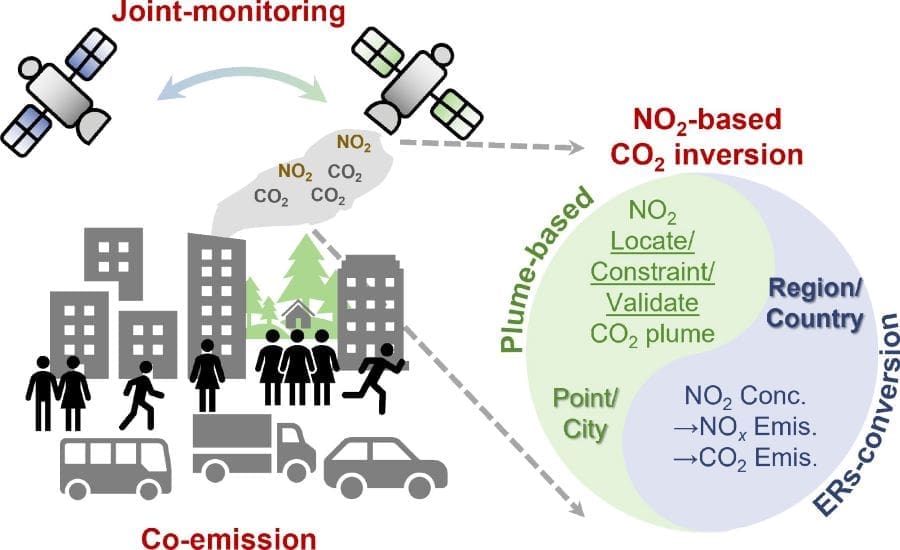Summary:
Monitoring fossil fuel CO2 emissions is crucial for climate action, but traditional methods often struggle to distinguish anthropogenic sources from natural background levels.
A review published in Frontiers of Environmental Science & Engineering explores a novel approach using satellite observations of nitrogen dioxide (NO2) as a proxy for tracking CO2 emissions.
Researchers from Tsinghua University outline two primary methods: plume-based analysis, which identifies CO2 plumes based on NO2 patterns, and an emission ratio-based approach, converting NO2 data into CO2 estimates. These techniques provide a more accurate and scalable means of tracking emissions at local and national levels. However, challenges remain, including data uncertainties and the need for advanced satellite technology. The study highlights how improved monitoring systems can enhance climate policies and emission reduction strategies worldwide.

Enhancing climate action: satellite insights into fossil fuel CO2 emissions
Reliable and accurate monitoring of CO2 emissions is a cornerstone of effective climate change mitigation strategies. While traditional methods largely depend on ground-based measurements and bottom-up inventories, these approaches are often resource-intensive and prone to errors.
Satellite technology has emerged as a promising alternative, but the challenge remains in distinguishing anthropogenic emissions from natural processes. The long atmospheric lifetime of CO2 makes it difficult to pinpoint localized sources of emissions and track changes over time. Additionally, natural emissions and background concentrations can obscure signals from human activity. To overcome these hurdles, new, more advanced monitoring techniques are needed.
On October 18, 2024, a team from Tsinghua University published a review in Frontiers of Environmental Science & Engineering, presenting a novel method to monitor fossil fuel CO2 emissions by utilizing satellite observations of NO2. This method offers a more reliable and scalable solution for tracking emissions, from localized sources like power plants to broader national levels.
The review introduces two primary methodologies to use NO2 as a proxy for CO2 emissions, taking advantage of its shorter atmospheric lifetime and enhanced detectability. The first method, the plume-based approach, uses NO2 observations to locate and validate CO2 plumes, providing a precise way to identify emissions from point sources such as power plants and industrial facilities. By tracking the movement of NO2 plumes, researchers can more accurately determine the origin and magnitude of CO2 emissions. This method is particularly useful in urban environments with multiple emission sources, as it allows for the differentiation of emissions from various facilities.
The second method, the emission ratio-based approach, involves estimating NOx emissions from NO2 data and converting these estimates into CO2 emissions using known CO2-to-NOx emission ratios. This technique is especially effective for larger spatial scales, such as national or regional assessments, where direct CO2 observations might be compromised by high background concentrations. By incorporating emission ratios, this method accounts for variations in fuel types and combustion processes, offering a more reliable estimation of CO2 emissions.
The study also addresses the uncertainties inherent in these methods, including structural uncertainties in the relationship between NO2 and emissions, as well as data-related challenges like retrieval errors and the accuracy of prior emissions inventories. To reduce these uncertainties, the researchers recommend the deployment of next-generation satellites with enhanced capabilities and the development of more sophisticated inversion systems.
Dr. Bo Zheng, an associate professor at Tsinghua University and a leading author of the study, commented: “This research marks a significant leap forward in our ability to monitor and verify CO2 emissions. By utilizing NO2 as a proxy, we can achieve much greater accuracy and reliability in emission estimates, which is crucial for implementing effective climate policies.”
The study’s findings have far-reaching implications for global climate policy and environmental management. Accurate emissions monitoring is critical for countries to assess their progress toward meeting their climate commitments under the Paris Agreement.
This new technology can support the development of more targeted and effective mitigation strategies, strengthening international efforts to combat climate change. Moreover, it provides researchers and policymakers with a valuable tool for understanding CO2 emission dynamics and their environmental consequences, paving the way for more informed decision-making in climate action.
Journal Reference:
Li, H., Qiu, J., Zhang, K. et al., ‘Monitoring fossil fuel CO2 emissions from co-emitted NO2 observed from space: progress, challenges, and future perspectives’, Frontiers of Environmental Science & Engineering 19, 2 (2025). DOI: 10.1007/s11783-025-1922-x
Article Source:
Press Release/Material by Higher Education Press
Featured image credit: NASA-Imagery | Pixabay




